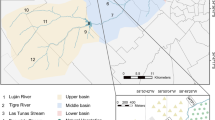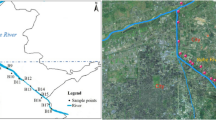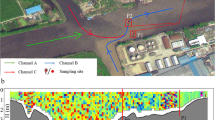Abstract
The aim of this study was to determine the impacts of anthropogenic disturbances on bacterial community composition in an urban river (Mooi River). Physico-chemical analysis, bacterial enumeration and 454-pyrosequencing were conducted on the Mooi River system upstream and downstream of an urban settlement in the North West Province, South Africa. Pyrosequencing and multivariate analysis showed that nutrient inputs and faecal pollution strongly impacted the physico-chemical and microbiological quality at the downstream sites. Also, bacterial communities showed higher richness and evenness at the downstream sites. Multivariate analysis suggested that the abundances of Betaproteobacteria, Epsilonproteobacteria, Acidobacteria, Bacteroidetes and Verrucomicrobia are related to temperature, pH, dissolved oxygen (DO), sulphate and chlorophyll-a levels. These results suggest that urbanisation caused the overall water quality of this river to deteriorate, which in turn affected the bacterial community composition. In addition, our work identified potential indicator groups that may be used to track faecal and organic pollution in freshwater systems.




Similar content being viewed by others

References
Ager D, Evans S, Li H, Lilley AK, Van der Gast CJ (2010) Anthropogenic disturbance affects the structure of bacterial communities. Environ Microbiol 12(3):670–678
Altmann D, Stief P, Amann R, De Beer D, Schramm A (2003) In situ distribution and activity of nitrifying bacteria in freshwater sediment. Environ Microbiol 5(9):798–803
Bhowal S, Chakraborty R (2011) Five novel acid-tolerant oligotrophic thiosulfate-metabolizing chemolithotrophic acid mine drainage strains affiliated with the genus Burkholderia of Betaproteobacteria and identification of two novel soxB gene homologues. Res Microbiol 162(4):436–445
Bricheux G, Morin L, Le Moal G, Coffe G, Balestrino D, Charbonnel N, Bohatier J, Forestier C (2013) Pyrosequencing assessment of prokaryotic and eukaryotic diversity in biofilm communities from a French river. Microbiol Open 2(3):402–414
Brümmer IHM, Fehr W, Wagner-Döbler I (2000) Biofilm community in polluted rivers: abundance of dominant phylogenetic groups over a complete annual cycle. Appl Environ Microb 66(7):3078–3082
Chen Y-G, Zhang Y-Q, Huang K, Tang S-K, Cao Y, Shi J-X, Xiao H-D, Cui X-L, Li W-J (2009) Pigmentiphaga litoralis sp. nov., a facultatively anaerobic bacterium isolated from a tidal flat sediment. Int J Syst Evol Micr 59(3):521–525
Chinivasagam HN, Corney BG, Wright LL, Diallo IS, Blackall PJ (2007) Detection of Arcobacter spp. in piggery effluent and effluent irrigated soils in southeast Queensland. J Appl Microbiol 103(2):418–426
Collado L, Inza I, Guarro J, Figueras MJ (2008) Presence of Arcobacter spp. in environmental waters correlates with high levels of fecal pollution. Environ Microbiol 10(6):1635–1640
Crump BC, Hobbie JE (2005) Synchrony and seasonality in bacterioplankton communities of two temperate rivers. Limnol Oceanogr 50(6):1718–1729
De Figueiredo DR, Pereira MJ, Moura A, Silva L, Bárrios S, Fonseca F, Henríques I, Correia A (2007) BCC over a dry winter in meso- and eutrophic Portuguese water bodies. FEMS Microbiol Ecol 59(3):638–650
De Figueiredo DR, Pereira MJ, Correia A (2010) Seasonal modulation of bacterioplankton community at a temperate eutrophic shallow lake. World J Microb Biot 26(6):1067–1077
De Figueiredo DR, Ferreira RV, Cerqueira M, Condesso De Melo T, Pereira MJ, Castro BB, Correia A (2012) Impact of water quality on bacterioplankton assemblage along Cértima River Basin (central western Portugal) assessed by PCR-DGGE and multivariate analysis. Environ Monit Assess 184(1):471–485
Decker CF, Hawkins RE, Simon GL (1992) Infections with Pseudomonas paucimobilis. Clin Infect Dis 14(3):783–784
Djordjevic Z, Folic MM, Zivic Z, Markovic V, Jankovic SM (2013) Nosocomial urinary tract infections caused by Pseudomonas aeruginosa and Acinetobacter species: sensitivity to antibiotics and risk factors. Am J Infect Control 41(12):1182–1187
Drury B, Rosi-Marshall E, Kelly JJ (2013) Wastewater treatment effluent reduces the abundance and diversity of benthic bacterial communities in urban and suburban rivers. Appl Environ Microb 79(6):1897–1905
DWAF (1996) Department of Water Affairs and Forestry. South African Water Quality Guidelines, 1st ed. Volume 8: Field Guide.
DWAF (2009) Directorate national water resource planning. Department of Water Affairs and Forestry, South Africa, September 2009. Integrated water quality management plan for the Vaal River System: task 2: water quality status assessment of the Vaal River system. Report No. P RSA C000/00/2305/1.
Edwards ML, Lilley AK, Timms-Wilson TH, Thompson IP, Cooper I (2001) Characterisation of the culturable heterotrophic bacterial community in a small eutrophic lake (Priest Pot). FEMS Microbiol Ecol 35(3):295–304
Eiler A, Langenheder S, Bertilsson S, Tranvik LJ (2003) Heterotrophic bacterial growth efficiency and community structure at different natural organic carbon concentrations. Appl Environ Microb 69(7):3701–3709
Eiler A, Bertilsson S (2007) Flavobacteria blooms in four eutrophic lakes: linking population dynamics of freshwater bacterioplankton to resource availability. Appl Environ Microb 73(11):3511–3518
Eiler A, Heinrich F, Bertilsson S (2012) Coherent dynamics and association networks among lake bacterioplankton taxa. ISME J 6(2):330–342
Evtushenko LI, Dorofeeva LV, Subbotin SA, Cole JR, Tiedje JM (2000) Leifsonia poae gen. nov., sp. nov., isolated from nematode galls on Poa annua, and reclassification of ‘Corynebacterium aquaticum’ Leifson 1962 as Leifsonia aquatica (ex Leifson 1962) gen. nov., nom. rev., comb. nov. and Clavibacter xyli Davis et al. 1984 with two subspecies as Leifsonia xyli (Davis et al. 1984) gen. nov., comb. nov. Int J Syst Evol Micr 50(1):371–380
Fong TT, Mansfield LS, Wilson DL, Schwab DJ, Molloy SL, Rose JB (2007) Massive microbiological groundwater contamination associated with a waterborne outbreak in Lake Erie, South Bass Island, Ohio. Environ Health Persp 115(6):856–864
Ford TE (2000) Response of marine microbial communities to anthropogenic stress. J Aquat Ecosyst Stress Recovery 7(1):75–89
Gavigan J-A, Leonard MM, Dobson ADW (1999) Regulation of polyphosphate kinase gene expression in Acinetobacter baumannii 252. Microbiology 145(10):2931–2937
Ghosh M, Verma SC, Mengoni A, Tripathi AK (2004) Enrichment and identification of bacteria capable of reducing chemical oxygen demand of anaerobically treated molasses spent wash. J Appl Microbiol 96(6):1278–1286
Goñi-Urriza M, Capdepuy M, RAymond N, Quentin C, Caumette P (1999) Impact of an urban effluent on the bacterial community structure in the Arga River, Spain, with special reference to culturable Gram-negative rods. Can J Microbiol 45(10):826–832
Haller L, Tonolla M, Zopfi J, Peduzzi R, Wildi W, Poté J (2011) Composition of bacterial and archaeal communities in freshwater sediments with different contamination levels (Lake Geneva, Switzerland). Water Res 45(3):1213–1228
HDA (2012) The Housing Development Agency. Informal settlement status, South Africa
Ho HT, Lipman LJ, Gaastra W (2006) Arcobacter, what is known and unknown about a potential foodborne zoonotic agent! Vet Microbiol 115(1–3):1–13
Horňák K, Jezbera J, Šimek K (2008) Effects of a Microcystis aeruginosa bloom and bacterivory on bacterial abundance and activity in a eutrophic reservoir. Aquat Microb Ecol 52(2):107–117
Iwegbue CMA, Arimoro FO, Nwajei GE, Eguavoen OI (2012) Concentrations and distribution of trace metals in water and streambed sediments of Orogodo River, Southern Nigeria. Soil Sediment Contam 21(3):382–406
Jordaan K, Bezuidenhout CC (2013) The impact of physico-chemical water quality parameters on bacterial diversity in the Vaal River, South Africa. Water SA 39(3):365–376
Kalwasińska A, Kęsy J, Donderski W, Lalke–POrczyk E (2008) Biodegradation of carbendazim by planktonic and benthic bacteria of eutrophic lake Chełmżyńskie. Pol J Environ Stud 17(4):515–523
Kamjunke N, Buttner O, Jager CG, Marcus H, Von Tumpling W, Halbedel S, Norf H, Brauns M, Baborowski M, Wild R, Borchardt D, Weitere M (2013) Biogeochmical patterns in a river network along a land use gradient. Environ Monit Assess 185(11):9221–36
Kirchman DL (2012) Processes in microbial ecology. Oxford University Press, New York
Kisand V, Cuadros R, Wikner J (2002) Phylogeny of culturable estuarine bacteria catabolizing riverine organic matter in the northern Baltic Sea. Appl Environ Microb 68(1):379–388
Kisand V, Andersson N, Wikner J (2005) Bacterial freshwater species successfully immigrate to the brackish water environment in the northern Baltic. Limnol Oceanogr 50:945–956
Lane DJ (1991) 16S/23S rRNA sequencing. In: Stackebrandt E, Goodfellow M (eds) Nucleic acid techniques in bacterial systematics. John Wiley & Sons, New York, pp 115–175
Laque T, Farjalla VF, Rosado AS, Esteves FA (2010) Spatiotemporal variation of bacterial community composition and possible controlling factors in tropical shallow lagoons. Microbial Ecol 59(4):819–829
Larsen PE, Field D, Gilbert JA (2012) Predicting bacterial community assemblages using an artificial neural network approach. Nat Methods 9:621–625
Lee J-S, Shin YK, Yoon J-H, Takeuchi M, Pyun Y-R, Park Y-H (2001) Sphingomonas aquatilis sp. nov., Sphingomonas koreensis sp. nov. and Sphingomonas taejonensis sp. nov., yellow-pigmented bacteria isolated from natural mineral water. Int J Syst Evol Micr 51(4):1491–1498
Li W, Shen Z, Tian T, Liu R, Qiu J (2012) Temporal variation of heavy metal pollution in urban stormwater runoff. Front Environ Sci En 6(5):692–700
Lin S, Wang Y, Lin J, Quan C (2014) Response of planktonic and benthic microbial community to urban pollution from sewage discharge in Jilin reach of the second Songhua River, China. Clean – Soil Air Water 42(10):1376–1383
Lindström ES, Vrede K, Leskinen E (2004) Response of a member of the Verrucomicrobia, among the dominating bacteria in a hypolimnion, to increased phosphorus availability. J Plankton Res 26(2):241–246
Lindström ES, Kamst-van Agterveld MP, Zwart G (2005) Distribution of typical freshwater bacterial groups is associated with pH, temperature, and lake water retention time. Appl Environ Microb 71(12):8201–8206
Liu Z, Huang S, Sun G, Xu Z, Xu M (2012) Phylogenetic diversity, composition and distribution of bacterioplankton community in the Dongjiang River, China. FEMS Microbiol Ecol 80(1):30–44
Lu X-M, Lu P-Z (2014) Characterization of bacterial communities in sediments receiving various wastewater effluents with high-throughput sequencing analysis. Microbial Ecol 67(3):612–623
Madhaiyan M, Poonguzhali S, Saravanan VS, Hari K, Lee K-C, Lee J-S (2013) Duganella sacchari sp. nov. and Duganella radices sp. nov., two novel species isolated from rhizosphere of field-grown sugar cane. Int J Syst Evol Micr 63:1126–1131
Magee JG, Ward AC (2012) Genus I. Mycobacterium. In: Goodfellow M, Kämpfer P, Busse H-J, Trujillo ME, Suzuki K, Ludwig W, Whitman B (eds) Bergey’s manual of systematic bacteriology, vol 5, 2nd edn. The Actinobacteria. Springer, New York, pp 312–375
Marcel KA, Antoinette AA, Mireille D (2002) Isolation and characterization of Aeromonas species from an eutrophic tropical estuary. Mar Pollut Bull 44(12):1341–1344
Markúsdóttir M, Heiðmarsson S, Eyþórsdótti A, Magnússon KP, Vilhelmsson O (2013) The natural and anthropogenic microbiota of Glerá, a sub-arctic river in northeastern Iceland. Int Biodeter Biodegr 84:192–203
Martinuzzi S, Januchowski-Hartley SR, Pracheil BM, McIntyre PB, Plantinga AJ, Lewis DJ, Lewis DJ, Radeloff VC (2014) Threats and opportunities for freshwater conservation under future land use change scenarios in the United States. Glob Change Biol 20(1):113–24
Mckinney ML (2006) Urbanization as a major cause of biotic homogenization. Biol Conserv 127(3):247–260
Mclellan SL, Huse SM, Mueller-Spitz SR, Andreishcheva EN, Sogin ML (2010) Diversity and population structure of sewage-derived microorganisms in wastewater treatment plant influent. Environ Microbiol 12(2):378–392
Newton RJ, Jones SE, Eiler A, Mcmahon K, Bertilsson S (2011) A guide to the natural history of freshwater lake bacteria. Microbiol Mol Biol Rev 75(1):14–49
O’Driscoll M, Clinton S, Jefferson A, Manda A, McMillan S (2010) Urbanization effects on watershed hydrology and in-stream processes in the southern United States. Water 2(3):605–648
Paerl HW, Dyble J, Moisander PH, Noble RT, Piehler MF, Pinckney JL, Steppe TF, Twomey L, Valdes LM (2003) Microbial indicators of aquatic ecosystems change: current applications to eutrophication studies. FEMS Microbiol Ecol 46(3):233–246
Paissé S, Coulon F, Goñi-Urriza M, Peperzak L, McGenity TJ, Duran R (2008) Structure of bacterial communities along a hydrocarbon contamination gradient in a coastal sediment. FEMS Microbiol Ecol 66(2):295–305
Parker JL, Shaw JG (2011) Aeromonas spp. clinical microbiology and disease. J Infect 62(2):109–118
Paver SF, Kent AD (2010) Temporal patterns in glycolate-utilizing bacterial community composition correlate with phytoplankton population dynamics in humic lakes. Microbial Ecol 60(2):406–418
Pereira RM, DA Silveira EL, Scaquitto DC, Pedrinho EAN, Val-Moraes SP, Wickert E, Carareto-Alves LM (2006) Molecular characterization of bacterial populations of different soils. Braz J Microbiol 37(4):439–447
Pesce S, Fajon C, Bardot C, Bonnemoy F, Portelli C, Bohatier J (2008) Longitudinal changes in microbial planktonic communities of a French river in relation to pesticide and nutrient inputs. Aquat Toxicol 86(3):352–360
Pinyakong O, Habe H, Omori T (2003) The unique aromatic catabolic genes in sphingomonads degrading polycyclic aromatic hydrocarbons (PAHs). J Gen Appl Microbiol 49(1):1–19
Rice EW, Baird RB, Eaton AD, Clesceri LS (2012). Standard methods for the examination of water and wastewater, 22nd ed. American Public Health Association, American Water Works Association, Water Environment Federation
Rickard AH, McBain AJ, Ledder RG, Handley PS, Gilbert P (2003) Coaggregation between freshwater bacteria within biofilm and planktonic communities. FEMS Microbiol Lett 220(1):133–140
SABS (2010) South African Bureau of Standards, Water–Nitrate and nitrite content. 2nd ed. Standards South Africa
Sartory DP, Grobbelaar JU (1984) Extraction of chlorophyll a from freshwater phytoplankton for spectrophotometric analysis. Hydrobologia 114(3):177–187
Schloss PD, Westcott SL, Ryabin T, Hall JR, Hartmann M, Hollister EB, Lesniewski RA, Oakley BB, Parks DH, Robinson CJ, Sahl JW, Stres B, Thallinger GG, Van Horn DJ, Weber CF (2009) Introducing MOTHUR: open-source, platform-independent, community-supported software for describing and comparing microbial communities. Appl Environ Microb 75(23):7537–7541
Schloss PD, Gevers D, Westcott SL (2011) Reducing the effects of PCR amplification and sequencing artifacts on 16S rRNA-based studies. PloS ONE 6:e27310
Sigee DC (2005) Freshwater microbiology: biodiversity and dynamic interactions of microorganisms in the aquatic environment. John Wiley & Sons, England
Šimek K, Horňák K, Jezbera J, Nedoma J, Znachor P, Hejzlar J, Sed’a J (2008) Spatio-temporal patterns of bacterioplankton production and community composition related to phytoplankton composition and protistan bacterivory in a dam reservoir. Aquat Microb Ecol 51(3):249–262
Singh J, Behal A, Singla N, Joshi A, Birbian N, Singh S, Bali V, Batra N (2009) Metagenomics: concept, methodology, ecological inference and recent advances. Biotechnol J 4(4):480–494
Spring S, Wagner M, Schumann P, Kämpfer P (2005) Malikia granosa gen. nov., sp. nov., a novel polyhydroxyalkanoate- and polyphosphate accumulating bacterium isolated from activated sludge, and reclassification of Pseudomonas spinosa as Malikia spinosa comb. nov. Int J Syst Evol Micr 55(2):621–629
Stabili L, Cavallo RA (2011) Microbial pollution indicators and culturable heterotrophic bacteria in a Mediterranean area (Southern Adriatic Sea Italian coasts). J Sea Res 65(4):461–469
Stats SA (2011) Census 2011. http://www.statssa.gov.za/census2011/default.asp. Accessed 10 February 2013.
Struthers M, Wong J, Janda JM (1996) An initial appraisal of the clinical significance of Roseomonas species associated with human infections. Clin Infect Dis 23(4):729–733
Táncsics A, Szabó I, Baka E, Szoboszlay S, Kukolya J, Kriszt B, Márialigeti K (2010) Investigation of catechol 2,3-dioxygenase and 16S rRNA gene diversity in hypoxic, petroleum hydrocarbon contaminated groundwater. Syst Appl Microbiol 33(7):398–406
Van der Gucht K, Vandekerckhove T, Vloemans N, Cousin S, Muylaert K, Sabbe K, Gillis M, Declerk S, De Meester L, Vyverman W (2005) Characterization of bacterial communities in four freshwater lakes differing in nutrient load and food web structure. FEMS Microbiol Ecol 53(2):205–220
Van der Walt IJ, Winde F, Nell B (2002) Integrated catchment management: the Mooi River (North West Province, South Africa) as a case study. Cuadernos de Investigación Geográfica 28:109–126
Vishnivetskaya TA, Mosher JJ, Palumbo AV, Yang ZK, Podar M, Brown SD, Brooks SC, Gu B, Southworth GR, Drake MM, Brandt CC, Elias DA (2011) Mercury and other heavy metals influence bacterial community structure in contaminated Tennessee streams. Appl Environ Microb 77(1):302–311
Wakelin SA, Colloff MJ, Kookana RS (2008) Effect of wastewater treatment plant effluent on microbial function and community structure in the sediment of a freshwater stream with variable seasonal flow. Appl Environ Microb 74(9):2659–2668
Wang Q, Garrity GM, Tiedje JM, Cole JR (2007) Naïve Bayesian classifier for rapid assignment of rRNA sequences into the new bacterial taxonomy. Appl Environ Microb 73(16):5261–5267
Yergeau E, Lawrence JR, Sanschagrin S, Waiser MJ, Korber DR, Greera CW (2012) Next-generation sequencing of microbial communities in the Athabasca River and its tributaries in relation to oil sands mining activities. Appl Environ Microb 78(21):7626–7637
Yi H, Li Z, Shuying Z, Shuguang X (2011) Comparison of bacterioplankton communities in three heavily polluted streams in China. Biomed Environ Sci 24(2):140–145
Zafiriou OC, Joussot-Dubien J, Zepp RG, Zika RG (1984) Photochemistry of natural waters. Environ Sci Technol 18(12):358A–371A
Zampini M, Stevens PR, Pachebat JA, Kingston-Smith A, Mur LAJ, Hayes F (2015) RapGene: a fast and accurate strategy for synthetic gene assembly in Escherichia coli. Scientific Reports 5:11302. doi:10.1038/srep11302
Zarraonaindia I, Smith DP, Gilbert JA (2013) Beyond the genome: community-level analysis of the microbial world. Biol Philos 28(2):261–282
Acknowledgments
This work was supported by the Water Research Commission (WRC), South Africa, under project K5/1966. The authors kindly thank the cartographer, Liesl De Swardt (North-West University, Potchefstroom campus), for generating the geographical map.
Author information
Authors and Affiliations
Corresponding author
Additional information
Responsible editor: Robert Duran
Rights and permissions
About this article
Cite this article
Jordaan, K., Bezuidenhout, C.C. Bacterial community composition of an urban river in the North West Province, South Africa, in relation to physico-chemical water quality. Environ Sci Pollut Res 23, 5868–5880 (2016). https://doi.org/10.1007/s11356-015-5786-7
Received:
Accepted:
Published:
Issue Date:
DOI: https://doi.org/10.1007/s11356-015-5786-7



